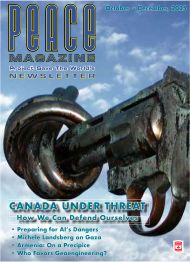In Gaza and Sudan people are starving again. What to do?
A report on a Save The World Forum with Timmo Gaasbeek.
Famine, again. For years, many of us believed the world had pushed mass starvation into the past. Then came today’s overlapping wars, climate shocks, and economic collapses—and the word is back on our lips. In a wide-ranging conversation hosted by Metta Spencer and Jill Carr-Harris for Project Save the World, Dutch irrigation engineer and researcher Timmo Gaasbeek offers a sobering tour of the present and a grounded look at what can still work.
p. The conversation opens with a jolt because it shows the scale of disaster. Sudan, a country of roughly 50 million people before the current war, now has about 30 million going hungry. Millions have fled, and about 10 million are internally displaced. In percentage terms, Gaza is currently the worst hunger crisis in the world,Gaasbeek notes, but Sudan’s sheer numbers—and the distances, dangers, and disrupted systems involved—make it a catastrophe of staggering breadth.
p. Gaasbeek knows Sudan and crises like it from the ground up. He trained in irrigation engineering, then spent years in conflict-affected regions: Cambodia, Sri Lanka, and later Sudan and Rwanda. His doctoral work focused on the conflict during SriLanka’s war and how people living in mixed or neighboring communities tried to keep everyday life functioning across ethnic lines. That eye for the everyday—how people actually eat, trade, plant, fetch water, and negotiate with neighbors when things fall apart—runs through the entire discussion.
WAR AND FOOD ACCESS
The hunger picture in Sudan, he explains, is a tangle of production collapse, import disruption, and siege conditions. Before the war, Sudan produced around two-thirds of its grain and imported the rest. When war broke out, both production and imports dropped sharply—by about 40 percent. Some areas had decent rains, but farmers often couldn’t get fertilizer or safely plant. Earlier carryover grain stocks softened the blow at first;those buffers are now thin. People are supplementing with peanuts, sesame, and in some cases meat—if they can afford it—and some are reportedly eating wild foods or even leaves, which provide scant calories. In parts of the country, famine conditions have been formally established. Gaasbeek points to the besieged city of El Fasher in North Darfur, where hundreds of thousands of people remain and reports say food is not entering; people have been surviving on livestock fodder, and even that is running out.
The situation is compounded by a collapsed health and nutrition system. Specialized therapeutic foods for acutely malnourished children— which save lives when delivered early—became far harder to produce locally after a key factory in Khartoum was destroyed early in the war. Some supplies are being brought in by agencies like UNICEF, but they are not reaching the most insecure areas consistently. The logistics alone are punishing: getting supplies from the nearest port into Darfur is roughly a 2,000-kilometer overland haul, through areas that may be unsafe or closed.
Carr-Harris brings in the human gradient of hunger she has witnessed across India’s drought-prone districts: from undernourishment to acute malnutrition and, at the worst point, starvation deaths. She notes the way chronic shortages damage children’s growth and lifelong prospects, especially under age five. India, she says, has dramatically reduced starvation deaths through public distribution and social protection, though pockets of extreme vulnerability remain.
Those gradations are a useful lens for Sudan: there are people “managing”—barely—and those who are not. It’s why, she adds, some speak of the “weaponization of food” in modern conflicts, when access to food or the means to prepare it is deliberately cut.
FOOD IMPORTS TO SUDAN
For all that, one of the counterintuitive insights from Sudan is about where most food actually comes from. Even during the last two war years, Gaasbeek notes, humanitarian food aid accounted for only about 1–2 percent of the total available cereals in the country. The vast majority of food moving in Sudan has been commercially imported or locally produced and then sold on the market. The difference is that humanitarian stocks can be targeted to the very hungriest places and populations; commercial grain simply lands where there is money or trade routes.
That makes targeted community solutions—like soup kitchens and communal meals—particularly valuable, because they can purchase from local markets and still reach those with no purchasing power.
Spencer asks whether community kitchens and humanitarian workers are more at risk today; in Gaza, aid providers have been attacked while delivering food. Gaasbeek is cautious here, saying he doesn’t track global trends over decades and focuses on specific contexts. But the implication is clear: hunger response is an increasingly dangerous job wherever conflict parties restrict access, and the ethics of providing food collide with militarized control of territory.
If that paints a grim present, the discussion also reaches for the practical: what actually helps when everything is fraying? Gaasbeek contrasts today’s Sudan with Ethiopia’s 1984 famine. Back then, drought played a central role. Today’s hunger in Sudan is driven far more by war and economic breakdown than rainfall alone, even if climate stress is a backdrop. He argues that local solutions should be the first choice when possible: supporting production, markets, and community mechanisms. But when the food deficit is too large and cannot be met locally, imports are necessary.
Often, he says, commercial imports are cheaper than shipping in donated aid commodities, though of course they are not a substitute for targeted humanitarian deliveries where markets do not reach or have been deliberately cut off.
The conversation shifts toward water, community agency, and how local decisions can either mend or inflame social fractures. From 2014 to 2018, Gaasbeek lived in Khartoum and managed a program that helped communities plan water resources across catchments in Darfur and eastern Sudan. The idea was deceptively simple: start small, listen, let local people map their needs and priorities—whether irrigation, drinking water, or sanitation—and build consensus before installing infrastructure.
As informal collaboration gained strength, communities could then approach higher-level authorities together. It borrowed from his Sri Lanka research, where he had observed that formal peace talks often amplify boundary-keepers, while everyday cooperation among farmers and neighbors tends to be quieter, adaptive, and, at times, more resilient.
Carr-Harris recognizes the pattern from her own work in India. Watershed projects, small dams, and other water-harvesting structures can be anchors of collective effort in dryland areas. When people co-manage water, they gain confidence and a sense of self-reliance that carries into other development choices. Even if conflict interrupts and infrastructure is damaged or seized, the habits and relationships built around shared resources can outlast the violence and be revived later.
WHO GETS WHICH ASSETS?
But Gaasbeek adds a caution: shared infrastructure is not automatically peace-building. When a new asset appears, it can also become a new point of contention—who gets access, when, and how much. In Sri Lanka, he found that parallel identities matter. Two people might be divided by ethnicity, yet both are farmers. Talking about farming can be less dangerous than talking about politics. Trust built in that “parallel lane” can, sometimes, soften harder divides later. It’s not romantic, he stresses; in warzones, people who bridge divides can face suspicion from all sides.
He recalls a water manager who was tortured by each armed group in turn, accused of collaboration simply for trying to keep irrigation running. Outsiders should tread lightly, support from below, and avoid forcing visibility on fragile local accords before they are strong enough to withstand public scrutiny.
Spencer asks whether being a foreigner offered Gaasbeek protection in conflict zones. In Sri Lanka, he says, he visited when it was relatively calm. When fighting flared and villages were destroyed, he stayed away; people fled and later returned, and only then could research resume. In other words, he did not have to walk a daily line through live combat.
Many international workers did spend time in conflict areas, but their access was episodic and heavily conditioned by the shifting war. In Sudan, by contrast, he and his family lived in Khartoum during what he calls the “relatively good years,” when oil revenues had spurred investment and, for those who could afford it, the capital was a comfortable city. The contrast with today is stark.
What does all this suggest for those watching from afar, asking how to help? Several threads emerge.
- Scale and targeting both matter. Sudan’s hunger crisis is enormous, and most calories are still moving through markets, not aid distributions. Getting commercial imports flowing and affordable, while using targeted aid to reach the completely destitute or besieged, is essential.
- Logistics are destiny. You can’t feed people if you can’t reach them. A 2,000-kilometer supply line into a warzone means fuel, security, and access negotiations realistically shape who eats and who doesn’t.
- Community kitchens and local procurement are practical bridges.
They convert market food into meals for people without cash, and they can be nimble if supplied—even modestly—with funds and safe spaces to operate.
- Local agency is not a luxury. Helping communities plan water and food systems builds the connective tissue that keeps life going under stress and speeds recovery when guns fall silent.
- Beware unintended consequences. New wells, canals, or aid distributions can trigger conflict if access rules aren’t co-designed and trusted. Start small, build consensus, and strengthen informal cooperation before elevating it.
- Children cannot wait. Therapeutic food pipelines and basic health services save lives quickly. Protecting factories, clinics, and corridors for pediatric nutrition is a non-negotiable in any response.
FAMINE, A FAILURE OF GOVERNANCE
Finally, the conversation circles back to the larger truth: famine today is less often a failure of production than a failure of peace, access, and governance. People can and do survive on astonishingly little for a time—on roots, wild foods, or leaves—but at terrible cost to their bodies and futures.
When war makes staples scarce and incomes vanish, hunger spreads not because the world has no food, but because it cannot reach, or is prevented from reaching, those who need it. That is a problem with human solutions and with human obstacles in the way.
Project Save the World’s forum guest didn’t promise quick fixes. He offered a clear-eyed account of what’s failing, where relief actually comes from, and how local strengths can be supported without being crushed by the weight of conflict. That grounded guidance is exactly what we need.



